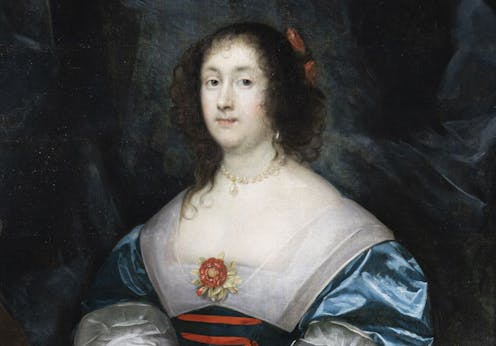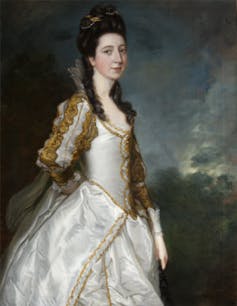
For the everyday visitor to a gallery or museum, alterations to artworks made years, sometimes decades, after their original creation are rarely obvious. After all, the skill of the modern art conservator is for their work to remain imperceptible at normal viewing distance, thus retaining the integrity of the original artwork.
Modern-day art conservators tend to favour minimal interventions – avoiding both painting over original paint and changing the picture. The idea these days is that any interventions – such as cleaning varnish, mending tears, or in-painting (retouching) – should not interfere with the artist’s original intent.
Early restorers took a completely different approach. Art restorers of the past quite often used oil paints to retouch, for example, which becomes difficult to remove and changes colour over time. Past restorers sometimes even undertook radical restorations to the subject itself.
Such is the case for a portrait of English aristocrat Diana Cecil (1596–1654), owned by English Heritage. Alterations to her features that were revealed recently during contemporary conservation show the extent to which early restorers could change an image in their attempt to “improve” an artwork. Using a rather broad-brush approach, the results of their work can remain for hundreds of years – as this case has shown.
Cecil’s features were altered by adding a layer of new paint over the original portrait, plumping her lips and thickening her hair. With modern scientific examination, it is possible for conservators to accurately distinguish between later additions and original paint. Nowadays, removal of over-paint happens under a microscope, using surgical methods.
The idea of conserving originality and removing the over-paint seems right. After all, it is the work of the original artist, Cornelius Johnson, and not the anonymous restorer that the viewer wishes to see, though the additions do lend an interesting element to the painting’s story.
Restorers of the past
In many cases, these dramatic changes were a result of poor skills. But early restoration decisions were also influenced by changing fashions for beauty and dress, modesty and the desire to cover naked bodies, politics, or simply practical necessity – such as difficulty with cleaning or having to hide traces of damage.
A particularly famous case was the botched Ecce Homo (more commonly, Spanish Jesus) painting, whose memorable makeover manifested as a complete obliteration of the original.
Another interesting example is the portrait of noblewoman Suky Trevelyan which now hangs at Wallington Hall, Northumberland. In 1771, its owner, John Hudson Trevelyan (Suky’s husband) made the first payment for alterations to her portrait. The final payment was made in 1776 by Trevelyan herself, by then a widow, in order to change the image yet again. The painting had originally been commissioned by her father for her 25th birthday.

The then-relatively unknown Thomas Gainsborough was hired to paint the portrait in 1761. However, it appears the work did not prove as popular as Trevelyan’s father had hoped. It was frequently dubbed “The Hat and Ruffles” by family members, indicating that Trevelyan’s likeness was somewhat obscured by her outsized choice of apparel.
As a result, the entire image was repainted during the 1770s by Sir Joshua Reynolds’ studio and drapery painters – covering up the large hat and abundant ruffles as well as Trevelyan’s dog, which she had fondly held in her arms. In 2011, I was able to reveal the original image, which hadn’t been seen for centuries, by taking an X-ray of the painting.
In this case, removal of over-paint would be akin to altering the sitter’s choice of presentation (in modern terms, editing the selfie). While capturing the likeness of a sitter is the skill of the artist, the accuracy of this particular “likeness” was dictated by the client, who may have had very specific views and requirements.
In contrast to Cecil’s recently uncovered touch-ups, the drapery artist who altered Trevelyan’s painting was careful not to paint over the original face. It’s possible that this was out of respect for the original, as Gainsborough was still an active and well-known artist.
Cecil’s portrait was probably restored after her lifetime, when she would no longer have a say in how she was presented. Thanks to modern conservators, Johnson’s fine brushwork has been revealed again. It bears signs of cracks and ageing but, after hundreds of years, it is not surprising the wrinkles are beginning to show.

Looking for something good? Cut through the noise with a carefully curated selection of the latest releases, live events and exhibitions, straight to your inbox every fortnight, on Fridays. Sign up here.
Nicky Grimaldi does not work for, consult, own shares in or receive funding from any company or organization that would benefit from this article, and has disclosed no relevant affiliations beyond their academic appointment.
This article was originally published on The Conversation. Read the original article.







